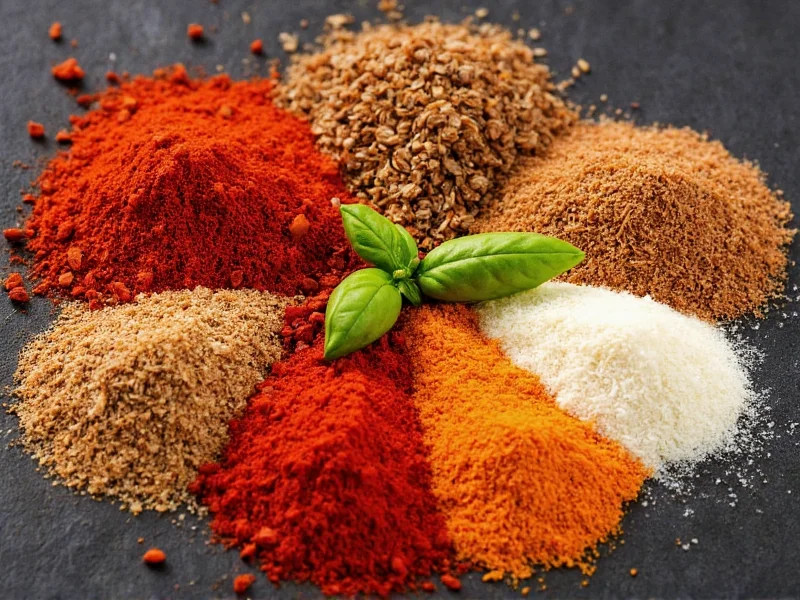Creating exceptional spaghetti sauce begins with understanding how spices interact with tomatoes and other ingredients. The magic happens when you combine the right spices in proper proportions and add them at optimal times during cooking. This guide reveals professional techniques for seasoning spaghetti sauce that transform basic tomato sauce into restaurant-quality creations.
Core Spices for Authentic Spaghetti Sauce
Every great spaghetti sauce starts with a solid foundation of essential spices. These ingredients form the backbone of traditional Italian flavor profiles:
- Basil - Provides sweet, slightly peppery notes. Use fresh basil added at the end for vibrant flavor, or dried basil early in cooking for deeper integration
- Oregano - Offers earthy, slightly bitter complexity. Mediterranean oregano works better than Mexican varieties for Italian sauces
- Garlic - Forms the aromatic base. Fresh minced garlic added early creates depth, while roasted garlic added later provides milder sweetness
- Onion - Builds foundational sweetness. Yellow onions work best, but shallots provide more delicate flavor
- Red pepper flakes - Adds controlled heat. Start with 1/4 teaspoon per quart of sauce and adjust to preference
Secondary Spices That Elevate Your Sauce
Once you've mastered the basics, these additional spices can create distinctive flavor profiles:
- Fennel seeds - Essential for meat sauces, especially with Italian sausage (1/2 teaspoon per pound of meat)
- Thyme - Adds earthy notes that complement tomatoes (use sparingly - 1/4 teaspoon dried or 1 sprig fresh)
- Bay leaves - Contributes subtle complexity (1 leaf per quart, removed before serving)
- Parsley - Fresh flat-leaf parsley added at the end provides brightness
- Rosemary - Use very sparingly (1/8 teaspoon dried) as it can dominate other flavors
When to Add Spices for Optimal Flavor Development
The timing of spice addition dramatically affects your spaghetti sauce's final flavor. This professional technique ensures balanced seasoning throughout the cooking process:
| Spice Type | Best Addition Time | Reason |
|---|---|---|
| Dried herbs (oregano, basil) | First 15 minutes of cooking | Need time to rehydrate and release flavors into the sauce |
| Garlic and onions | When sautéing aromatics | Develops foundational flavor base through caramelization |
| Fennel seeds | When browning meat | Releases oils that infuse the fat and meat |
| Fresh herbs (basil, parsley) | Last 5-10 minutes of cooking | Preserves volatile oils and fresh flavor notes |
| Bay leaves | Middle of cooking process | Requires extended time but can become bitter if overcooked |
Regional Variations in Spaghetti Sauce Seasoning
Authentic Italian cooking varies significantly by region, and understanding these differences helps create more genuine spaghetti sauce:
Northern Italian sauces typically feature more subtle seasoning with emphasis on fresh herbs added at the end. Southern Italian versions often include more robust spice profiles with generous use of red pepper flakes and dried herbs that have simmered for hours. American-Italian spaghetti sauce has evolved its own traditions, frequently incorporating more sugar to balance tomato acidity and larger quantities of garlic than found in traditional Italian recipes.
For authentic Neapolitan-style sauce, focus on high-quality San Marzano tomatoes with minimal seasoning beyond fresh basil and a touch of oregano. Roman-style sauces often include a hint of mint or extra garlic. When creating homemade spaghetti sauce seasoning blend, consider which regional approach aligns with your desired flavor profile.
Common Spaghetti Sauce Spice Mistakes
Even experienced cooks make these frequent errors when seasoning spaghetti sauce:
- Over-spicing - Adding too many different spices creates confusion rather than complexity. Stick to 3-5 primary spices for clarity of flavor
- Using stale spices - Ground spices lose potency after 6 months. Test freshness by rubbing between fingers - if little aroma emerges, replace them
- Incorrect timing - Adding fresh herbs too early cooks out their delicate flavors
- Imbalanced acid-sweet profile - Tomatoes vary in acidity; adjust with small amounts of sugar or grated carrot rather than masking with excessive spices
- Not tasting as you go - Seasoning spaghetti sauce properly requires incremental adjustments throughout cooking
Creating Your Signature Spaghetti Sauce Spice Blend
Developing a consistent homemade spaghetti sauce seasoning blend ensures restaurant-quality results every time. Start with this professional ratio as your foundation, then adjust to personal preference:
For every quart of tomato sauce, begin with: 1 teaspoon dried oregano, 1/2 teaspoon dried basil, 2 minced garlic cloves, 1/4 teaspoon red pepper flakes, and 1/2 teaspoon onion powder. Simmer for 20 minutes, then taste and adjust. Add fresh basil and parsley during the final 5 minutes of cooking.
Document your successful combinations to recreate favorite batches. Store dried spice blends in airtight containers away from light and heat, where they'll maintain potency for 3-6 months. Remember that fresh herbs generally use a 3:1 ratio compared to dried (3 parts fresh to 1 part dried) when substituting.
Special Considerations for Dietary Needs
When accommodating dietary restrictions, spaghetti sauce spices offer flexible solutions:
For low-sodium diets, replace salt with additional garlic, onion, and herb content to maintain flavor depth. Those with nightshade sensitivities can create satisfying sauces using roasted carrots and bell peppers for sweetness, with extra oregano and basil providing familiar Italian notes. Gluten-free diets don't affect spice selection, but check pre-made blends for potential fillers.
Vegan spaghetti sauce benefits from umami-rich additions like dried mushrooms (soaked and minced) or a splash of soy sauce to replace meat-based depth. When cooking for children, reduce red pepper flakes and consider adding a pinch of cinnamon for subtle sweetness that adults won't detect.











 浙公网安备
33010002000092号
浙公网安备
33010002000092号 浙B2-20120091-4
浙B2-20120091-4